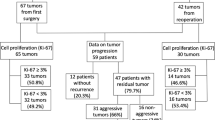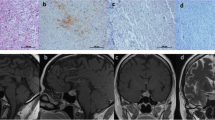Abstract
To determine the frequency of human telomerase reverse transcriptase (hTERT) catalytic fraction expression and its association with clinical and demographic characteristics of the patient, as well as with the expression of CD34 and proliferating cell nuclear antigen (PCNA) indexes on adenohypophyseal hormone tissues. A transverse study was realized with 49 cases of hypophyseal adenoma with analysis type cases and controls. The different adenohypophyseal hormones [prolactin (PRL), growth hormone (GH), follicle stimulating hormone, luteinizing hormone, thyroid gland stimulant hormone, adrenocorticotropic hormone (ACTH)], the catalytic fraction of the telomerase hTERT, the PCNA index and the CD34 density were determined by means of immunohistochemical techniques. The clinical, demographic and histopathological characteristics of the patients with and without hTERT expression were compared by means of Pearson’s Chi-squared, Fisher’s exact test and Mann–Whitney’s U. Twenty-eight point six percent of the adenomas had positive expression for hTERT. The variables significantly correlated with hTERT’s expression were younger age of presentation, diagnostic of adenoma producer, higher PCNA index, higher CD34 density, increased GH on serum and the expression on PRL tissue, GH and ACTH. Tobacco history had a negative association with hTERT’s expression. The telomerase could be a marker of cellular proliferation associated with angiogenesis and hormonal activity. Evaluation of these variables could provide information about their biological behavior.


Similar content being viewed by others
References
Hardy J (1969) Transphenoidal microsurgery of the normal and pathological pituitary. Clin Neurosurg 16:185–217
Kovacs K, Horvath E, Vidal S (2001) Classification of pituitary adenomas. J Neurooncol 54:121–127
Asa SL (1994) Disease of the pituitary. Neuropathology 5:71–95
Ahmed A, Tollefsbol T (2003) Telomeres, telomerase, and telomerase inhibition: clinical implications for cancer. J Am Geriatr Soc 51:116–122
Nakatani K, Yoshimi N, Mori H, Yoshimura S, Sakai H, Shinoda J, Sakai N (1997) The significant role of telomerase activity in human brain tumors. Cancer 80:471–476
Hiraga S, Ohnishi T, Izumoto S, Miyahara E, Kanemura Y, Matsumura H, Arita N (1998) Telomerase activity and alterations in telomere length in human brain tumors. Cancer Res 58:2117–2125
Toh WH, Kyo S, Sabapathy K (2005) Relief of p53-mediated telomerase suppression by p73. J Biol Chem 280:17329–17338
DeMasters BK, Markham N, Lillehei KO, Shroyer KR (1997) Differential telomerase expression in human primary intracranial tumor. Am J Clin Pathol 107:548–554
Hiyama E, Hiyama K, Nishiyama M, Reynolds CP, Shay JW, Yokoyama T (2003) Differential gene expression profiles between neuroblastomas with high telomerase activity and low telomerase activity. J Pediatr Surg 38:1730–1734
Didiano D, Shalaby T, Lang D, Grotzer MA (2004) Telomere maintenance in childhood primitive neuroectodermal brain tumors. Neuro-oncology 6:1–8
Bratthauer GL, Adams LR (1994) Immunohistochemistry: antigen detection in tissue. In: Mikel UV (ed) Advanced laboratory methods in histology and pathology. Armed Forces Institute of Pathology, American Registry of Pathology, Washington
Arrieta O, Guevara P, Tamariz J, Rembao D, Rivera E, Sotelo J (2002) Antiproliferative effect of thalidomide alone and combined with carmustine against C6 rat glioma. Int J Exp Pathol 83:99–104
Li TJ, Browne RM, Matthews JB (1994) Quantification of PCNA+ cells within odontogenic jaw cyst epithelium. J Oral Pathol Med 23:184–189
Xia Y-P, Zhao Y, Marcus J, Jimenez PA, Ruben SM, Moore PA, Khan F, Mustoe TA (1999) Effects of keratinocyte growth factor-2 (KGF-2) on wound healing in an ischaemia-impaired rabbit ear model and on scar formation. J Pathol 188:431–438
Niveiro M, Aranda FI, Peiró G, Alenda C, Pico A (2005) Immunohistochemical analysis of tumor angiogenic factors in human pituitary adenomas. Hum Pathol 36:1090–1095
Harley CB, Futcher AB, Greider CW (1990) Telomeres shorten during ageing of human fibroblasts. Nature 345:458–460
Counter CM, Avilion AA, LeFeuvre CE, Stewart NG, Greider CW, Harley CB, Bacchetti S (1992) Telomere shortening associated with chromosome instability is arrested in immortal cells which express telomerase activity. EMBO J 11:1921–1929
Kotoula V, Barbanis S, Nokolakaki E, Koufoyannis D, Papadimitriou CS, Karkavelas G (2004) Relative expression of human telomerase catalytic subunit (hTERT) transcripts in astrocytic gliomas. Acta Neuropathol (Berl) 107:443–451
Dong CK, Masutomi K, Hahn WC (2005) Telomerase: regulation, function and transformation. Crit Rev Oncol Hematol 54:85–93
Sebastian S, Grammatica L, Paradiso A (2005) Telomeres, telomerase and oral cancer. Int J Oncol 27:1583–1596
Langford LA, Piatyszek MA, Xu R, Schold SC Jr, Shay JW (1995) Telomerase activity in human brain tumours. Lancet 346:1267–1268
Yoshino A, Katayama Y, Fukushima T, Watanabe T, Komine C, Yokoyama T, Kusama K, Moro I (2003) Telomerase activity in pituitary adenomas: significance of telomerase expression in predicting pituitary adenoma recurrence. J Neurooncol 63:155–162
Tanaka Y, Hongo K, Tada T, Sakai K, Kakizawa Y, Kobayashi S (2003) Growth pattern and rate in residual nonfunctioning pituitary adenomas: correlations among tumor volume doubling time, patient age, and MIB-1 index. J Neurosurg 98:359–365
Harada K, Arita K, Kurisu K, Tahara H (2000) Telomerase activity and the expression of telomerase components in pituitary adenoma with malignant transformation. Surg Neurol 53:267–274
Vidal S, Kovacs K, Horvath E, Scheithauer BW, Kuroki T, Lloyd RV (2001) Microvessel density in pituitary adenomas and carcinoma. Virchows Arch 438:595–602
Turner HE, Nagy Z, Gatter KC, Esiri MM, Harris AL, Wass JA (2000) Angiogenesis in pituitary adenomas-relationship to endocrine function, treatment and outcome. J Endocrinol 165:475–481
Itoh J, Serizawa A, Kawai K, Ishii Y, Teramoto A, Osamura RY (2003) Vascular networks and endothelial cells in the rat experimental pituitary glands and in the human pituitary adenomas. Microsc Res Tech 60:231–235
Turner HE, Harris AL, Melmed S, Wass JA (2003) Angiogenesis in endocrine tumors. Endocr Rev 24:600–632
Yamada S, Takada K (2003) Angiogenesis in pituitary adenomas. Microsc Res Tech 60:236–243
Tella JOI, Herculano MA, Delcelo R (2000) Pituitary adenomas: relationship between invasiveness and proliferative cell nuclear index. Arq Neuropsiquiatr 58:1055–1063
Bravo R, Frank R, Blundell PA, Macdonald-Bravo H (1987) Cyclin/PCNA is the auxiliary protein of DNA polymerase-delta. Nature 326:515–517
Blevins LS Jr, Verity DK, Allen G (1998) Aggressive pituitary tumors. Oncology 12:1307–1312
Hsu DW, Hakim F, Biller BM, de la Monte S, Zervas NT, Klibanski A, Hedley-Whyte ET (1993) Significance of proliferating cell nuclear antigen index in predicting pituitary adenoma recurrence. J Neurosurg 78:753–761
Schreiber S, Saeger W, Ludecke DK (1999) Proliferation markers in different types of clinically non-secreting pituitary adenomas. Pituitary 1:213–220
Klencki M, Kurnatowska I, Slowinska-Klencka D, Lewinski A, Pawlikowski M (2001) Correlation between PCNA expression and AgNOR dots in pituitary adenomas. Endocr Pathol 12:163–169
Nose-Alberti V, Mesquita MI, Martin LC, Kayath MJ (1998) Adrenocorticotropin-producing pituitary carcinoma with expression of c-erbB-2 and high PCNA index: a comparative study with pituitary adenomas and normal pituitary tissues. Endocr Pathol 9:53–62
Hashimoto K, Nagano I, Asaba K, Inoue M, Nishioka T, Takao T, Nakajo T, Mori T, Kurisaka M, Otsuka F (2000) Significant gene expression of insulin-like growth factor II and proliferating cell nuclear antigen in a rapidly growing recurrent pituitary acth-secreting adenoma. Horm Res 54:198–202
Bertholon-Gregoire M, Trouillas J, Guigard MP, Loras B, Tourniaire J (1999) Mono and plurihormonal thyrotropic pituitary adenoma pathological, hormonal and clinical studies in 12 patients. Eur J Endocrinol 140:519–527
Wolfsberger S, Wunderer J, Zachenhofer I, Czech T, Bocher-Schwarz HG, Hainfellner J, Knosp E (2004) Expression of cell proliferation markers in pituitary adenomas-correlation and clinical relevance of MIB-1 and anti-topoisomerase—IIalpha. Acta Neurochir (Wien) 146:831–839
Thapar K, Kovacs K, Scheithauer BW, Stefaneanu L, Horvath E, Pernicone PJ, Murray D, Laws ER Jr (1996) Proliferative activity and invasiveness among pituitary adenomas and carcinomas: an analysis using the MIB-1 antibody. Neurosurgery 38:99–106
Yonezawa K, Tamaki N, Kokunai T (1997) Clinical features and growth fractions of pituitary adenomas. Surg Neurol 48:494–500
Autrup H (1993) Transplacental transfer of genotoxins and transplacental carcinogénesis. Environ Health Perspect 101:33–38
Birrenbach T, Bocker U (2004) Inflammatory bowel disease and smoking: a review of epidemiology, pathophysiology, and therapeutic implications. Inflamm Bowel Dis 10:848–859
Lynch HT, Brand RE, Lynch JF, Fusaro RM, Kern SE (2002) Hereditary factors in pancreatic cancer. J Hepatobiliary Pancreat Surg 9:12–31
Razani-Boroujerdi S, Sopori ML (2006) Early manifestations of NNK-induced lung cancer: role of lung immunity in tumor susceptibility. Am J Respir Cell Mol Biol (Epub ahead of print)
Sasco AJ, Vainio H (1999) From in utero and childhood exposure to parental smoking to childhood cancer: a possible link and the need for action. Hum Exp Toxicol 18:192–201
Phillips LE, Longstreth WT Jr, Koepsell T, Custer BS, Kukull WA, van Belle G (2005) Active and passive cigarette smoking and risk of intracranial meningioma. Neuroepidemiology 24:117–122
Hurley SF, McNeil JJ, Donnan GA, Forbes A, Salzberg M, Giles GG (1996) Tobacco smoking and alcohol consumption as risk factors for glioma: a case-control study in Melbourne, Australia. J Epidemiol Community Health 50:442–446
Fuxe K, Andersson K, Eneroth P, Harfstrand A, Agnati LF (1989) Neuroendocrine actions of nicotine and of exposure to cigarette smoke: medical implications. Psychoneuroendocrinology 14:19–41
Andersson K (1985) Mecamylamine pretreatment counteracts cigarette smoke induced changes in hypothalamic catecholamine neuron systems and in anterior pituitary function. Acta Physiol Scand 125:445–452
Kapoor D, Jones TH (2005) Smoking and hormones in health and endocrine disorders. Eur J Endocrinol 152:491–499
Author information
Authors and Affiliations
Corresponding author
Rights and permissions
About this article
Cite this article
Ortiz-Plata, A., Tena Suck, M.L., López-Gómez, M. et al. Study of the telomerase hTERT fraction, PCNA and CD34 expression on pituitary adenomas. Association with clinical and demographic characteristics. J Neurooncol 84, 159–166 (2007). https://doi.org/10.1007/s11060-007-9365-8
Received:
Accepted:
Published:
Issue Date:
DOI: https://doi.org/10.1007/s11060-007-9365-8




